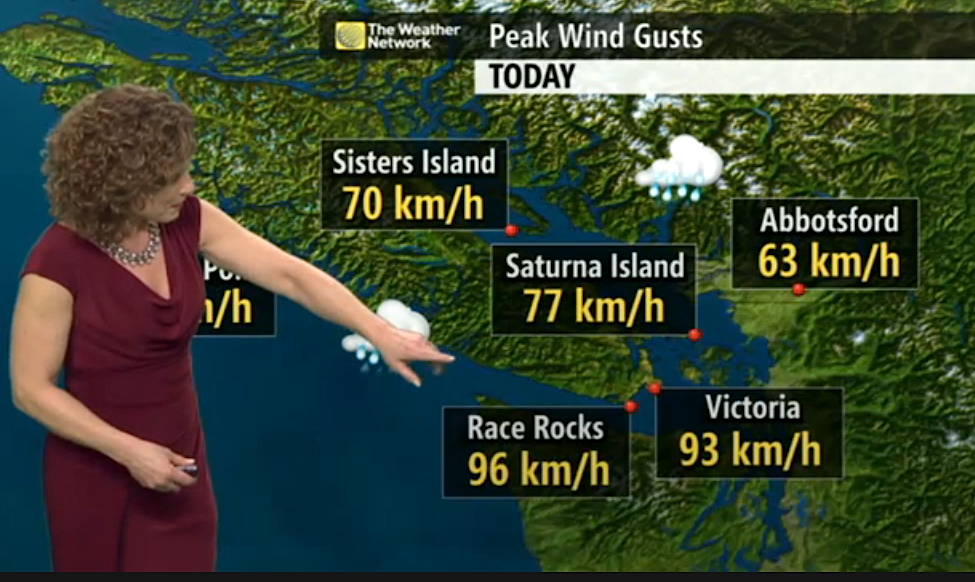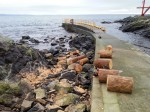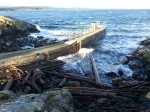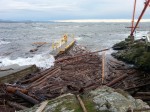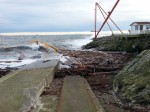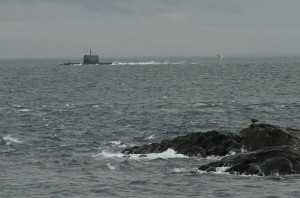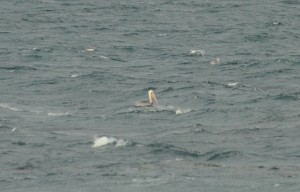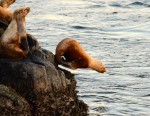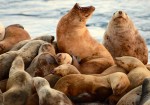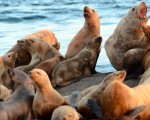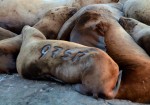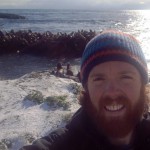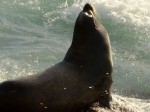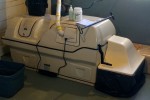This morning around 0700 hours we got some exceptional peak wind gusts that even got hilighted on the CBC Weather Network: 96 km /hr ( = 52 Knots)_
Tag Archives: wind
Logs and debris
NE wind has persisted, 25-30 knots all day. 3-4 foot waves rolling into the mouth of the jetty, continuing to bring in logs and debris due to high tides and wind direction.
- Dec 13. A log washed up…
- Dec 14. A few more start congregating…
- Dec 15. still coming in.
- Dec 15. boat ramp buried.
Have been doing a lot of cutting and collecting wood and frequent boat ramp clearing. Unfortunately the station pike pole is missing and the crane is out of order so it is difficult to clear it out logs.
Pelican, 50knot gusts
The barometer hit a low of below 985 hPa in the afternoon. Winds had been 10 to 20 knots N most of the day but picked up in the evening and switched to west late in the night, gusting over 50knots.
I spotted one pelican offshore in the reserve. Chunk was on the main island overnight but left around noon.
A submarine passed by close to the reserve.
A lot of wood debris got washed up on the boat ramp throughout the day and this evening. Collected lots of driftwood for burning. Working on compost toilet installation.
Shift Change?
The wind blew from the northeast between 17 and 27 knots. At 15:00, the wind died down a bit, blowing between 12 and 14 knots for several hours. The barometer dropped from 1014 hPa to 1008 hPa. The sky was clear, with some clouds in the south. Whitecaps rolled in from the northeast, calming down in the early afternoon. The temperature reached a high of 6.7oC at 15:00.
There was one whale watching boat seen in the reserve.
The winds, swell and tides combined to allow me to stay another day on the Rock. Between my time mopping the floors and tidying up inside the buildings, I observed sea lions through the binoculars. There were no branded or entangled sea lions observed. They all appear healthy. Many have moved on from Race Rocks, probably to go further up the west coast of Vancouver Island. It will be interesting to see how many are still here. We will have to wait until tomorrow’s census to find out.
- A cuddle puddle of steller sea lions on South Seal Rocks.
- There might be something tasty in the water for those gulls.
- A steller sea lion takes a leap into the water.
- A group of steller sea lions on South Seal Rocks.
Cold, Sea Lion Brands and Beautiful Sunset
The wind blew from the northeast, between 15 and 25 knots. The barometer rose in the morning from 1024 hPa and then dropped to 1020 hPa. The visibility was unlimited, with great views of Mt. Baker and many other wonders of the Salish Sea. The temperature reached a high of 2oC as I am writing this at 21:00.
The dive boat from Ogden Point visited at 11:00. The group was diving around Middle Rock.
I was going to leave on the Race Rocks boat this morning for a short trip into Pedder Bay to drop off garbage and pick up gas. A lot of garbage is being swept onto the shores of the ecological reserve. I thought I had a good window to get away from the jetty. Although, the northeasterly swell started to pick up just as I was putting the boat in the water. The waves were too high as they rolled into the jetty, so I changed my plans and raised the boat back into the boat house.
Two branded sea lions were spotted today. See the photos and captions below for 359Y and 975Y. In November there were 20 different brands spotted around Race Rocks. Many of those california and steller sea lions had never been spotted before at Race Rocks.
I collected depth soundings from all the tanks around campus for the month end report. 475L of diesel was used over the past month to power the generator and heat the houses. Last year in November, 737L of diesel was used. The reduction of diesel use by a third this year has come from increased power output from the solar array as well as the wood stove, which was installed last winter in the Ecoguardian’s House. There are lots more changes being made to transition to more sustainable power sources. Stay tuned to this blog to read about them as they are introduced.
- Check out the size difference between these steller sea lions. Males can weigh up to 566 kg (1,245 pounds) and females weigh up to 263 kg (579 pounds). They can live up to 20-30 years.
- A new sighting of a branded steller sea lion. This sea lion was branded 359Y in 2013, when it was a yearling at Rogue Reef, Oregon.
- Another new sighting of a branded steller sea lion. This sea lion was branded 975R in 2011, when it was a yearling at Rogue Reef, Oregon.
- The sun sets behind the Olympic Peninsula at 16:20. There are frozen ponds in the foreground.
- The sunset progressed to pink and orange tones.
Snow Day!
The wind was howling up to 38 knots from the north northeast last night, bringing with it a low of -2oC and a couple centimetres of snow. The temperature stayed just below 0oC for the rest of the day. The barometer rose from 999 hPa to 1022 hPa throughout the day, making for a bluebird sky. During the daylight hours, the wind continued to blow from the north northeast between 10 and 20 knots.
There was one whale watching boat seen in the reserve in the mid afternoon. Six divers from Ogden Point were exploring the undersea world of the reserve in the late morning.
The snow didn’t seem to faze the animals. The sea lions barked just as loud and the bald eagles tormented the gulls just as much. Some of the snow melted from the sun. There is still ice on some of the paths and rocks, as well as a light dusting of snow on the grass and in the places that were shaded by buildings and rocks.
Other than taking photos of snow, the tasks of the day included: running the desalinator, topping up the batteries with the generator, deconstructing the old washroom in the basement of the Marine Science Centre to accommodate the new composting toilet (it’s almost finished), fixing the wheelbarrow, testing the salinity and temperature of the water, and doing a load of laundry.
- Canada goose tracks on the snowy path.
- A bald eagle scares a large group of gulls from their perch on the northeast side of Great Race. Can you spot the eagle?
- The wind and snow blew from the north northeast overnight, evidenced by the snow encrusted lighthouse and tank house.
- Five california sea lions being loud and curious on the shore just below the lighthouse.
- A juvenile bald eagle takes off from the snowy South Islands.
- A selfie taken outside of the generator room, with the snow, sun and sea lions.
- The 58m factory trawler Osprey #1 travels east towards Vancouver from the fishing grounds of the Pacific. The ship is traveling between Bentick Island and Turbine Rock, which is in the foreground with a bald eagle and harbour seals.
Peregrine, Eagles and Wind
The wind gusts reached 39 knots from the west this morning. The general wind trend throughout the day was between 11 and 32 knots from the west, with slight fluctuations to the north and south. The barometer generally went down from 1001 hPa to 997 hPa, with a few dips upwards as the sun broke through the clouds.
The approaching Arctic blast of cold weather will bring a chance that the thermometer might drop from 7oC to below 0oC tonight for the first time in a while. Heating coils and warm thoughts have been deployed around the buildings to prevent pipes from freezing.
There was one whale watching boat seen in the reserve at 12:30. A couple boats gathered to view humpback whales to the east of the reserve in the mid afternoon.
There were a couple of bald eagles around for most of the day, one adult and one juvenile. At 10:00 in the morning, a peregrine falcon was chasing after the juvenile eagle over the north of Great Race and Middle Channel. The size difference of the eagle and peregrine took me by surprise. I had never seen the much smaller peregrine next to a bald eagle. This might be the same peregrine that Pam Birley has seen over the past week. It had dark chest feathers, which indicates it is a juvenile peregrine falcon.
The desalinator worked hard today to make about 800 litres of fresh water. With a maximum output of 1.5 litres per minute, the desalinator is a very energy intensive way to create water. Although, when the water is heated and added to a mix of leaves, spices and herbs, it makes great tea. A necessity for Race Rocks.
- A tanker heads westward, a couple kilometres from the shores of Race Rocks.
- A bald eagle perches on the northwest of Great Race, between flying circuits of the reserve.
- The flag flaps in the west wind, with gulls in the background having taken flight en masse because of an eagle fly by.
Eagles, waves and engine troubles
The barometer continued to rise today, from 1019 hPa to 1024 hPa. The wind blew from the west and southwest between 14 and 34 knots. The sky was mostly clear, with occasional brief showers and rainbows. There was a large swell coming in from the west.
There were no boats seen in the reserve today.
There were four bald eagles seen in the reserve this morning. Large groups of gulls got to practice their evasive manoeuvres as the eagles flew overhead. Our UK camera viewer, Pam Birley, spotted a peregrine falcon on the helicopter pad at 15:20.
I was unsuccessful in running the monthly check on the fire pump and refill of the salt water cistern, but not for lack of trying. I strung all the hoses from the jetty to the underground cistern, only to find that neither engine was willing to start and pump. I will continue to tinker with those engines. On the up side, I got to practice unrolling and rolling all the hoses.
- A california sea lion soaking up the sun and waves.
- South Seal Rock is overrun with sea lions and waves.
Black Brant Goose
Last night the anemometer was reading wind gusts of up to 53 knots from the southwest. That’s 100 km/h! As far as I can tell, nothing blew away overnight. There was a fresh load of driftwood delivered to the beaches. Today, the wind continued to blow from the southwest and west. The wind had low velocity in the morning, rising to the high twenties in the afternoon, and dropping to 11 in the evening. The barometer continued to rise from 990 hPa last night to a high of 1018 hPa tonight. The sky cleared up in the morning, with sun all day.
Four whale watching boats were seen in the reserve this afternoon.
This morning, I saw a black brant goose hanging out with the gulls on the northeast corner of Race Rocks. It was my first time seeing one of these small geese, which rarely visit Race Rocks. This goose might be making it’s way down to the Oregon, California or Mexican coast for winter, from it’s summer home in the Arctic. For more information about black brant geese, see the taxonomy page.
- A black brant goose makes a rare visit to Race Rocks.
- Black brant preening
- Black brant are one of the smallest and fastest of the flying geese.
- Canada geese with sea lions in the background
- Sea lions (mostly steller) gather on the South Islands. The largest sea lion appears to be on top.
- A sea lion leaps out of the water on the wavy west coast of the island
Humpback Whales
The wind blew at about 15 knots from the northeast for the daylight hours. A swell with small whitecaps from the northeast died down at noon. The barometer dropped slightly from 1031 to 1029 hPa. The sky was clear all day.
There were six whale watching boats seen in the reserve today. The only other boat was the Race Rocks boat making a round trip to Pedder Bay at noon, for an Ecoguardian switchover.
Over the weekend, Jeff completed the installation of the new composting toilet in the Ecoguardian’s house. It’s a big step up from the humanure system that was in place before. The new waterless system has a unit in the basement, directly below the toilet, that decomposes the human waste and only needs to be emptied once a year. An identical unit is going to be installed in the Marine Science Centre, once some minor wall demolition happens to accommodate unit in the basement.
- The bio-drum and collection chamber of the new Centrex 3000 composting toilet in the Ecoguardian’s House.
At 14:00, there were two or three humpback whales within a few hundred metres of the northeast of Great Race Rocks. They made their way to the south, diving for five minutes at a time and then resurfacing. Two whale watching boats remained with them for about 45 minutes, sometimes very close to the whales.
- The fluke of a humpback whale, with the shoreline of Esquimalt in the background
- The spray can be seen from two humpback whales between two whale watching boats. Mt. Baker is in the background.
- The fluke of a humpback whale a few hundred metres off of the northeast of Race Rocks

